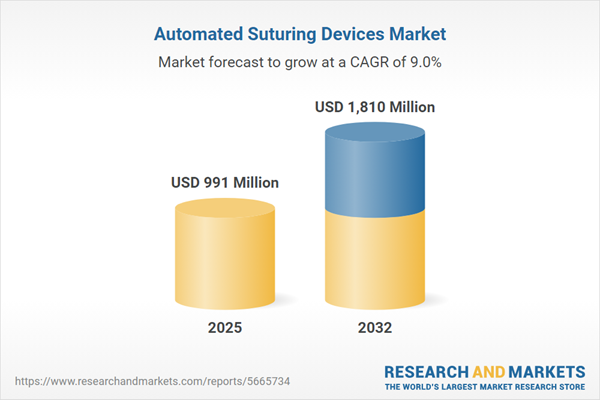Speak directly to the analyst to clarify any post sales queries you may have.
Automated suturing devices are reshaping the surgical landscape for healthcare providers seeking to standardize outcomes, improve efficiency, and drive consistent practices across sites. As adoption widens, these solutions are becoming central to operational strategies for senior decision-makers managing evolving clinical and regulatory requirements.
Automated Suturing Devices Market Snapshot
The automated suturing devices market is showing sustained, strong expansion. Global revenue is forecast to grow from USD 910.66 million in 2024 to USD 991.00 million by 2025, with a compound annual growth rate (CAGR) of 8.97% projected through 2032. This momentum reflects greater integration of automated suturing technology across hospital and outpatient settings, where streamlined workflows and reproducible procedural quality are top priorities. Leading industry providers are accelerating product innovation, enhancing device reliability and feature sets to help healthcare organizations respond to changing procedural needs. Recent advancements focus on operational durability and the ability to integrate new devices into diverse environments, all while maintaining compliance with complex regulatory requirements. As hospitals and clinics seek to futureproof their technology portfolios, automated suturing devices are central to achieving scalable, high-quality care delivery.
Scope & Segmentation of the Automated Suturing Devices Market
Defining clear market segments allows decision-makers to allocate resources and shape clinical strategy for modern care settings. Each segment supports alignment of procurement, safety, and workflow optimization with broader organizational objectives.
- Application Areas: Automated suturing devices support cardiovascular, colorectal, general, gynecological, and orthopedic surgeries, each with specific selection considerations to optimize procedural performance and inform post-operative pathways.
- End Users: Hospitals, ambulatory surgical centers, and specialty clinics differ in care intensity and case mix, requiring tailored deployment and procurement strategies.
- Product Types: Options for disposable and reusable suturing tools affect purchasing, cost management, and sustainability policies, making device type selection critical for long-term operational impact.
- Technology Modes: Innovations such as electrosurgical platforms—including bipolar and ultrasonic technologies—expand clinical decision-making, allowing providers to transition from purely mechanical suturing as needed for different case complexities.
- Suture Materials: Access to both absorbable and non-absorbable sutures enables cross-functional care teams to customize treatment and address diverse patient recovery requirements.
- Automation Levels: A range of semi-automatic and fully automatic devices is available, letting organizations tailor adoption to staff skills, workflow integration, and patient volume needs.
- Regions: Distinct regional factors in the Americas, Europe, Middle East & Africa, and Asia-Pacific—such as unique regulatory, reimbursement, and supply chain considerations—influence local adoption and drive tailored technology strategies.
- Leading Players: Key companies like Medtronic, Ethicon, B. Braun, ConMed, Teleflex, Smith & Nephew, Baxter, Olympus, 3M, and Intuitive Surgical actively shape procurement criteria, best practices, and cross-border deployment standards.
Key Takeaways for Strategic Planning
- Automated suturing devices help standardize procedure delivery, reducing clinical variability and supporting more consistent outcomes across multiple facilities.
- Integrating robotics, data analytics, and digital platforms strengthens clinical confidence, particularly in high-complexity cases where precision and timely decision-making are essential.
- Collaboration among device makers, clinical leaders, and researchers supports smoother adoption, accelerates continuous improvement, and promotes a safety-first approach within surgical teams.
- Procurement strategies are evolving to emphasize not only cost but also long-term performance, alignment with institutional needs, and measurable value over time.
- Performance-based technology models link procurement to key quality and operational outcomes, ensuring each investment supports strategic improvement goals.
- Advanced digital training tools and simulation resources expedite onboarding and device integration, fostering faster and more effective staff upskilling.
Tariff Impact on the Automated Suturing Devices Market
Recent US tariff policy changes have placed renewed attention on supply chain risk in the automated suturing devices market. Organizations are responding by diversifying supplier relationships, investing in domestic manufacturing capabilities, and pursuing stable, long-term agreements. These measures secure reliable access to devices and promote continuity across both mature and developing healthcare environments.
Methodology & Data Sources
This report is based on structured interviews with senior healthcare leaders, as well as input from procurement experts and surgical specialists. Research was validated by cross-referencing with current regulations, leading market studies, and respected industry journals to ensure actionable, evidence-driven recommendations.
Why This Report Matters to Senior Leaders
- Provides strategic insights, directly linking automated suturing devices to organizational objectives and capital planning decisions.
- Enhances risk management by highlighting early signals in regulations and supply chains to guide resilient operational strategies.
- Serves as a reliable benchmark for optimizing surgical device integration and supporting data-driven clinical and operational initiatives.
Conclusion
This analysis delivers a clear, evidence-based foundation for senior executives to guide technology evaluation and strategic planning, advancing robust and adaptable surgical care delivery frameworks.
Additional Product Information:
- Purchase of this report includes 1 year online access with quarterly updates.
- This report can be updated on request. Please contact our Customer Experience team using the Ask a Question widget on our website.
Table of Contents
3. Executive Summary
4. Market Overview
7. Cumulative Impact of Artificial Intelligence 2025
Companies Mentioned
The companies profiled in this Automated Suturing Devices market report include:- Ethicon, Inc.
- Medtronic PLC
- B. Braun Melsungen AG
- ConMed Corporation
- Teleflex Incorporated
- Smith & Nephew PLC
- Baxter International Inc.
- Olympus Corporation
- 3M Company
- Intuitive Surgical, Inc.
Table Information
| Report Attribute | Details |
|---|---|
| No. of Pages | 185 |
| Published | November 2025 |
| Forecast Period | 2025 - 2032 |
| Estimated Market Value ( USD | $ 991 Million |
| Forecasted Market Value ( USD | $ 1810 Million |
| Compound Annual Growth Rate | 8.9% |
| Regions Covered | Global |
| No. of Companies Mentioned | 11 |









